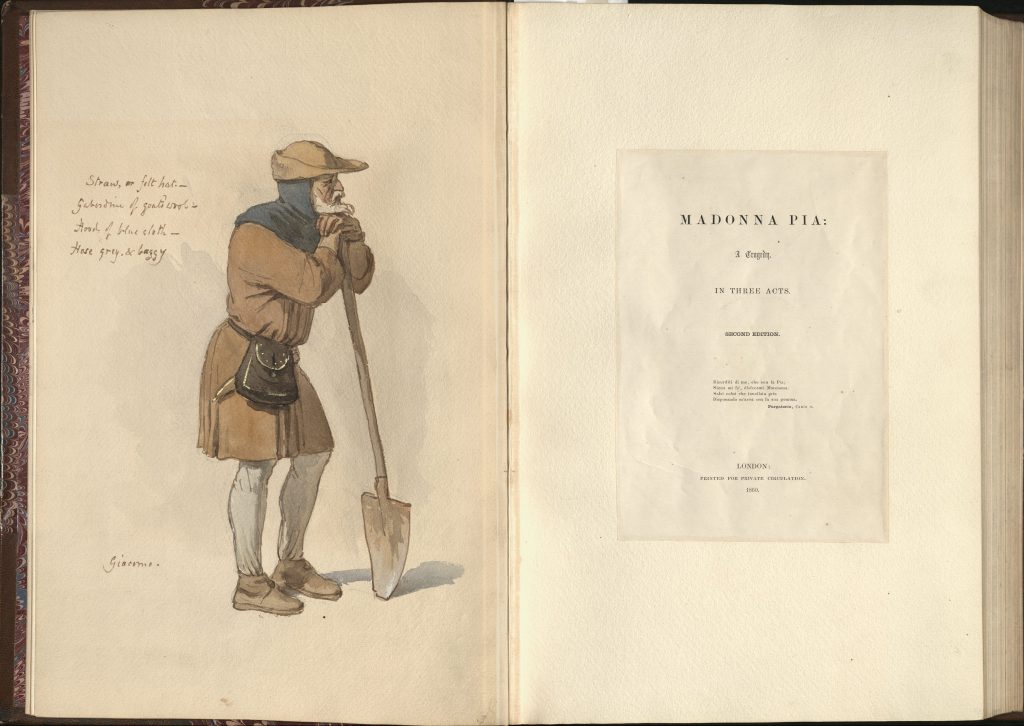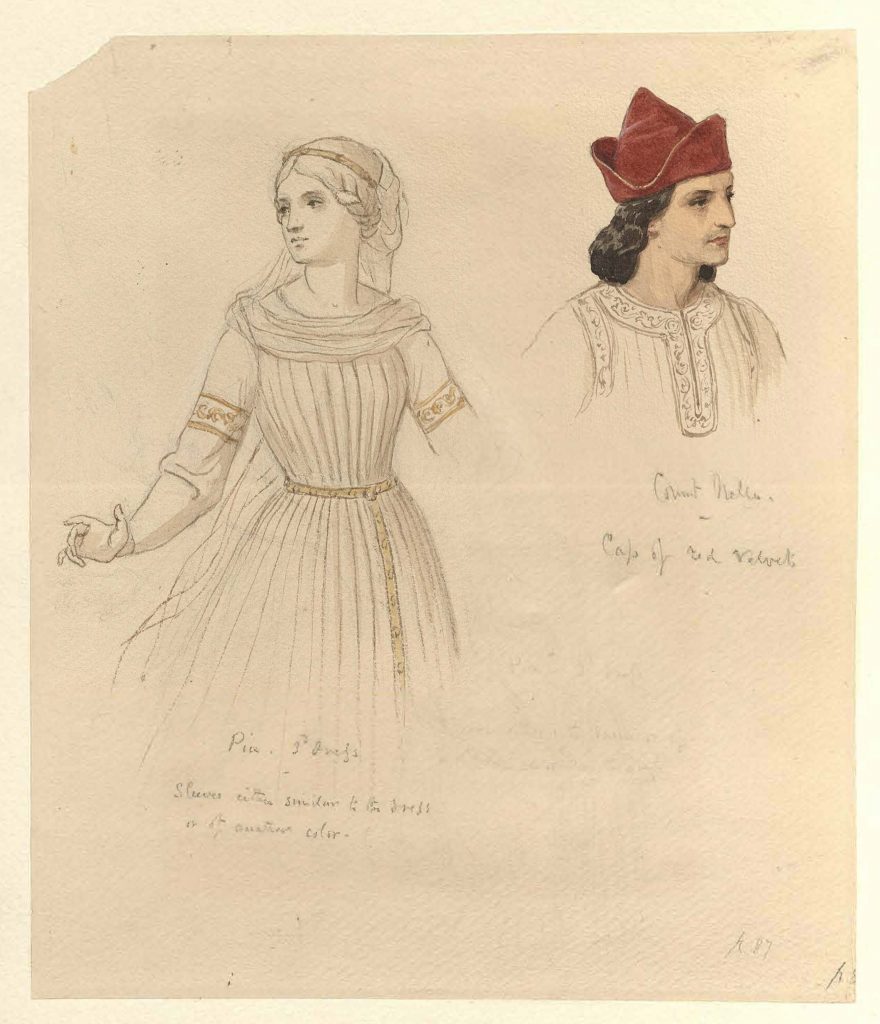Ireland’s Most Beloved Painter? Irish Art for St. Patrick’s Day
With St. Patrick’s Day falling on Sunday, this week we highlight some original artwork in Spencer’s collections by a notable Irish artist, Frederic William Burton (1816-1900).

Though Burton may not be a household name in the United States, his best-known work, “Hellelil and Hildebrand, the Meeting on the Turret Stairs” (1864), was voted Ireland’s favorite painting in a 2012 RTÉ poll.
That painting, housed at the National Gallery of Ireland, draws its theme from a medieval Danish ballad. As the museum’s label explains, the ballad tells the story of “Hellelil, who fell in love with her personal guard Hildebrand, Prince of Engelland. Her father disapproved of the relationship and ordered her seven brothers to kill the young prince.” Burton’s painting captures a moment of longing: a final fleeting meeting between the ill-fated couple.

One of the more astonishing aspects of the painting is that it is a watercolor (Burton always worked in watercolors rather than oils). To protect the painting from light damage, the National Gallery of Ireland has it on display for just two hours a week, keeping it behind protective panels the remainder of the time.
A more modest example of Burton’s artistry in watercolors resides at the Kenneth Spencer Research Library in a series of costume designs he made for a play by the writer Theodore Martin (more on this soon).
A native of Co. Clare, Frederic William Burton was born to a wealthy land-owning family. He moved to Dublin at ten and by sixteen had exhibited at the Royal Hibernian Academy. His early career was as a miniaturist and portraitist, always working in watercolors.
Through his friendship with the Irish antiquarian, George Petrie, Burton was inspired to turn to the Irish landscape and consider Irish subjects in his paintings, as in his 1841 watercolor The Aran Fisherman’s Drowned Child.
Burton’s connection to another friend, Thomas Davis, a leader of the nationalist Young Ireland movement, resulted in his contribution of the illustrated title page for The Spirit of the Nation (1845), an anthology of ballads and songs by Davis and other writers associated with periodical The Nation. At the time, however, Burton kept his contribution anonymous, reluctant to enter into the fray of politics. In a memorial tribute, Lady Gregory would recall that Burton had been in favor of Ireland’s union with England and did not share Davis’s nationalist politics, but that he had undertaken the title page to please his friend, “ there was nothing in the world he would not have done for Davis” [1]. Spencer Research Library’s multiple copies of The Spirit of the Nation deserve a St. Patrick’s Day post of their own. The copy pictured below contains two inserted leaves of inscriptions of Young Irelanders Terence Bellew MacManus, Thomas Francis Meagher, Patrick O’Donohoe, and William Smith O’Brien, signed from Clonmel Gaol in Tipperary, following their 1848 attempted nationalist rising. The signature of O’Brien is visible on the leaf tipped in next to Burton’s illustrated title page.

As noted earlier, Spencer Library’s collections also reveal another dimension of Burton’s career as an artist. We hold a copy of a special volume belonging to the attorney and writer Sir Theodore Martin (with his bookplate). It comprises pages of the 1860 privately printed second edition of Martin’s play Madonna Pia: A Tragedy juxtaposed with 11 original watercolors of costume designs. Though the sketches are not signed, Martin included in his special volume a manuscript letter from the artist signed “FWB” alongside a portrait of Burton, signaling his identity as the artist. The letter was sent in November 1855, the date of the first edition of Martin’s play, from Munich, where Burton was serving as curator of the Royal collection for Maximilian II of Bavaria.

In the letter, likely addressed to Martin’s wife, the actress Helena Faucit, Burton apologizes for the quality of his watercolors. He self-deprecatingly explains:
These hasty sketches are not indeed what I had intended – but just as I was engaged about them the Fine Arts were under a cloud from weather such as ever you Londoners need not have envied us. They are very scribbly & coarse — & I fear none of them will answer, – but you will gratify me by giving them to any little relatives you may have under five years of age to amuse themselves by sticking pins through them.


Fortunately for us, Martin preserved the watercolors and bound them together with a later edition of his play. Madonna Pia takes its inspiration from a passage in Dante’s Purgatorio to tell the story of Pia’s imprisonment and poisoning by her jealous husband, Count Nello della Pietra. It was a popular subject during the Victorian era; KU’s Spencer Museum of Art holds a later painting, Pia de’ Tolomei, by pre-Raphaelite artist Dante Gabriel Rossetti that references the same tale from Dante.
Three years after Frederic William Burton executed his “hasty sketches,” he took up residence in London. There, he was part of the circle of Rossetti and other Pre-Raphaelite artists, and it was during this time that he painted “Hellelil and Hildebrand, the Meeting on the Turret Stairs.” In 1874, Burton was made director of London’s National Gallery, and he retired from painting. Though he died in London on the day before St. Patrick’s Day in 1900, Burton returned to Ireland in death. He was buried in Dublin’s Mount Jerome Cemetery, and his work was exhibited at Dublin’s National Gallery later that same year. In her remembrance, Lady Gregory wrote that despite his years spent abroad, which left him “almost forgotten” in Dublin, Burton’s “heart was Irish to the last” [2].
Come examine Frederic William Burton’s watercolor sketches for Madonna Pia at Spencer Research Library, and then continue on to explore other materials in our Irish Collections. Not certain where to start? Take a glance at some past blog posts or explore our Irish Collections LibGuide.
Elspeth Healey
Special Collections Librarian
[1] Gregory, Lady Augusta. “Sir Frederic Burton.” The Leader: A Review of Current Affairs, Politics, Literature, Art and Industry. Vol 1, no. 15 (8 December 1900): 231. Call Number: O’Hegarty E98.
[2] ibid.
Works consulted include:
Caffrey, Paul. “Burton, Sir Frederic William (1816–1900), watercolour painter and art administrator.” Oxford Dictionary of National Biography. September 23, 2004. Oxford University Press. Date of access 11 Mar. 2019, http://www.oxforddnb.com/view/10.1093/ref:odnb/9780198614128.001.0001/odnb-9780198614128-e-4127.
Clarke, Frances. “Burton, Sir Frederic William.” Dictionary of Irish Biography. James McGuire, James Quinn, Editors. Cambridge, United Kingdom: Cambridge University Press, 2009. http://dib.cambridge.org/viewReadPage.do?articleId=a1216.
Tags: Frederic William Burton, Irish Art, Irish Collections, Madonna Pia, St. Patrick's Day, The Spirit of the Nation, Theodore Martin

